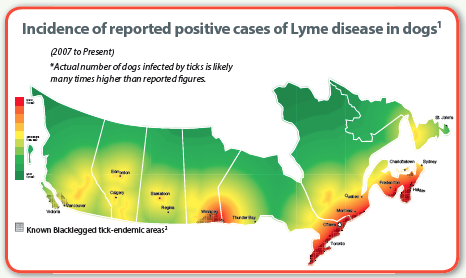 By Dr. Brendon Laing
By Dr. Brendon Laing
Last year in Southern Ontario ticks received a great deal of media attention due to their involvement in the transmission of Lyme disease. Unfortunately, this disease cannot only affects our pets, but us humans as well. In pets, clinical signs include: fever, loss of appetite, joint disease and, in severe cases kidney failure. In humans, symptoms may include fever, headache, swollen lymph nodes, cognitive dysfunction and nervous systemdisorders.
Many people are unaware that ticks emerged as a threat in Ontario back in 2009 and the government of Canada has been monitoring their progress ever since. Ticks have migrated from the eastern seaboard of the United States and colonized two areas of Canada – Kingston and Turkey Point. Since this time, they have spread approximately 43 kilometers a year surrounding Toronto. In the spring of 2015, the Rouge Valley near the Toronto Zoo, became classified as a ‘Lyme Hot Spot’, soon anticipated to be endemic. Unfortunately, Health Canada predicts Lyme disease will spread across all of Ontario by 2020.
So what are Ticks? Ticks are small bug-like parasites that spend most of their days living in forests and long grass. They lie awaiting a host (deer, dog, cat, human) to walk by at which point they grab hold of fur or skin. They do not jump as fleas do and, unlike fleas, who can bite up to 400 times a day, ticks only bite once. For the first 24 hours, ticks adhere themselves to their host. They burrow their heads into the skin and produce a numbing agent.
 The good news is that there are steps that you can take to protect you and your furry loved ones. When hiking in the woods wear closed-toe shoes, long-sleeved shirts and pants, pull your socks over your pant legs. The use of an insect repellent containing DEET and doing a full-body check for adult ticks may aid in tick prevention.
The good news is that there are steps that you can take to protect you and your furry loved ones. When hiking in the woods wear closed-toe shoes, long-sleeved shirts and pants, pull your socks over your pant legs. The use of an insect repellent containing DEET and doing a full-body check for adult ticks may aid in tick prevention.
Your veterinarian has topical and oral products that can help protect your pets. In addition, a Lyme vaccine is available for dogs who frequent forests known to have Lyme disease carrying ticks.
For even more detailed info on Ticks, we suggest reading Dr. Brian Laing’s ‘Tick Talk’ Blog. The page also contains a video of a live fully feed tick that he removed from a patient. Futhermore there is a video of his interview on Rogers Cable TV.




